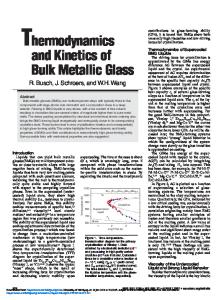Preparation of Zr-based Metallic Glass Wire for Biomedical Application
- PDF / 4,822,579 Bytes
- 9 Pages / 612 x 792 pts (letter) Page_size
- 53 Downloads / 317 Views
1048-Z08-13
Preparation of Zr-based Metallic Glass Wire for Biomedical Application Takeshi Nagase1, Koichi Kinoshita2, and Yukichi Umakoshi1 1 Division of Materials and Manufacturing Science, Graduate School of Engineering, Osaka University, 2-1, Yamada-oka, Suita, 565-0871, Japan 2 Division of Bioengineering, Graduate School of Engineering Science, Osaka University, 3-1, Machikaneyama-cho, Toyonaka, 560-8531, Japan ABSTRACT New Zr based metallic glass wires without bio-toxic elements of Ni, Al and Be were developed for the further application as biomaterials by arc-melting type melt-extraction method. The continuous metallic glass wires with a good white luster and smooth surface were obtained in Zr-Ti-Al-Co, Zr-Al-Co-Cu, Zr-Al-Co and Zr-Ti-Co alloys. The Zr-based metallic glass wires show high tensile strength reaching 1000MPa. Furthermore, the wires exhibit good bending ductility and can be bent through 180 degrees without fracture. The Zr-based metallic glass wires achieve simultaneously high tensile strength, good bending ductility and high thermal stability. INTRODUCTION Metallic amorphous alloys are well known to show superior mechanical properties such as high tensile strength, low Young's modulus and large elastic elongation limit of about 2% [1]. The wire shape sample with a circular cross section is favorable for use of the superior mechanical properties. Amorphous alloy wires with diameters ranging about 100 µm are obtained in Fe-, Co-, Ni-, Pd- and Pt- alloy systems by in-rotating-water melt-spinning method [2,3]. However, since liquid mediums must be used in the case of in-rotating-liquid melt spinning method, the alloy system is limited due to the high reactivity of these molten alloys with the liquid coolants. The melt-extraction method without any cooling medium [4,5] is expected to enable the formation of continuous amorphous wires with high reactivity in molten state such as Al-, Mg-, Ti- and
Figure 1. Schematic illustration of arc-melt type melt-extraction method used in the present study (a) and optical micrograph of the apparatus (b).
Zr-alloy systems [6-9]. Among the above described amorphous wires, Zr-based metallic glass wires are of great interest as a candidate of structural materials for biomedical application because of their unique mechanical properties, high glass forming ability (GFA), high corrosion resistance against biomedical environment [10] and superior medical MRI image [11]. Unfortunately, the Zr-based metallic glass with high GFA always contains bio-toxic elements such as Be, Al and Ni [10-13]. To replace Be, Al and Ni by a non-toxic element often leads the decrease in GFA, resulting in crystallization during solidification. Preparation of Zr-based amorphous wires in new alloys without any toxic elements is the most important problem for the application of Zr-based metallic glass as bio-materials. The aim of this paper is to try to prepare new Zr-based amorphous wires for biomedical application by arc-melting type melt-extraction method. EXPERIMENT Referring from the prev
Data Loading...











